Spatio-Temporal Evolution and Driving Factors of Tourism Economic Resilience in the Yili River Valley
Abstract
:1. Introduction
2. Literature Review
3. Overview of the Research Area
4. Methodology and Data Sources
4.1. Construction of the Indicator System
4.2. The Entropy Weight TOPSIS Method
4.3. Markov Chain
4.3.1. Traditional Markov Chains
4.3.2. Spatial Markov Chain
4.4. Grey Relation Analysis
- (1)
- Construction of the reference sequence and comparison sequence:
- (2)
- Data preprocessing: de-measurement tempering:
- (3)
- Calculation of the correlation coefficient of each indicator in the subseries with the parent series:
- (4)
- Calculation of correlation:
4.5. Data Sources
5. Results and Analysis
5.1. Characteristics of Spatio-Temporal Differentiation of Tourism Economic Toughness Level in the Yili River Valley
5.1.1. Time-Series Characteristics of Tourism Economic Resilience Level in the Yili River Valley
5.1.2. Spatial Characteristics of the Tourism Economic Resilience Level in the Yili River Valley
5.2. Characteristics of the Spatio-Temporal Evolution of Tourism Economic Resilience in the Yili River Valley
5.2.1. Center of Gravity Evolutionary Trajectory
5.2.2. Characterization of the Evolution of Spatial Dynamics
- (1)
- Traditional Markov chain analysis
- (2)
- Spatial Markov chain analysis
5.3. Analysis of the Drivers of the Spatial and Temporal Evolutionary Characteristics of Tourism Economic Resilience in the Yili River Valley
6. Conclusions and Discussion
6.1. Conclusions
- (1)
- From the point of view of temporal change and spatial distribution, during 2010–2019, the tourism economic toughness of the counties and cities in the Yili River Valley showed a “W”-shaped temporal change, with 2013–2014 and 2015–2016 being the trough period, which indicates the volatility of the tourism economic toughness in the region. Cities in the northwest, such as Yining City and Horgos City, show high levels of toughness, while the central-to-southeastern counties and cities show relatively low levels, and this spatial distribution pattern is characterized by being “high at both ends and low in the middle”.
- (2)
- The spatial and temporal evolution characteristics show that there is a stable agglomeration trend in the direction of “northwest–southeast” in the region. At the same time, the tourism economic resilience shows five convergence clubs with strong stability, and the neighboring environment has a significant influence on the transformation of the convergence club, and a high level of neighboring environment is conducive to the transformation of county and city units to a higher level of convergence club.
- (3)
- Regarding the driving factors, all indicators have a significant impact on the resilience of the tourism economy, with an influence of 0.77 or more. Among them, the number of employees in the tertiary industry, especially the high-quality labor force invested in the tourism industry, helps to improve the quality of tourism services and the development potential of the industry, and becomes the dominant factor for the tourism economy to be more resilient and elastic.
6.2. Discussion
- (1)
- The “W”-shaped time-series trend revealed in the paper, especially the decline in the resilience of the tourism economy between 2013–2014 and 2015–2016, may be related to multiple factors, such as global or regional economic fluctuations, unforeseen events and policy adjustments. This finding emphasizes the high sensitivity of the tourism economy to internal and external shocks, and the results of the study are consistent with the findings of the previous study by Smith et al. Therefore, policymakers need to build a dynamic monitoring system to identify risks in a timely manner, and at the same time strengthen resilience building, such as diversifying risks through diversified market strategies to enhance the flexibility and adaptability of the tourism industry. In the future, the Yili River Valley still needs to further improve marketization, enhance transportation accessibility, and strive to promote the transformation and upgrading of the industrial structure, so as to consolidate the infrastructure for tourism development. In addition, the macro policy should also strengthen the reasonable guidance to the tourism industry and try to avoid the negative impact of “black swan”, “gray rhino” and other events on the tourism economy.
- (2)
- The spatial distribution pattern of being “high on both sides and low in the middle” highlights the unevenness of regional development. The performance of cities in the northwest and counties and cities in the southwest illustrates the important contribution of infrastructure, industrial agglomeration and resource endowment to the resilience of the tourism economy. For the central to southeastern regions, the government should adopt differentiated support policies to increase investment in tourism infrastructure in these regions and improve the quality of tourism services, while focusing on sustainable tourism practices that protect natural landscapes and cultural heritage to enhance their core attractiveness. Through regional cooperation, the industrial layout should be optimized, and resource sharing and market linkages should be achieved to promote the overall enhancement and balanced development of the tourism economy.
- (3)
- Characterization of the spatio-temporal evolution shows that the economic resilience of tourism in the Yili River Valley is not only affected by time-series fluctuations but also shows obvious spatial aggregation and convergence phenomena. The stable pointing of the standard deviation ellipse and the existence of convergence clubs require policy makers to consider spatial proximity and inter-regional interaction in planning. High-level resilient regions should be encouraged to play a radiation-driven role and help low-level resilient regions upgrade through technology transfer and management experience sharing. Meanwhile, effective risk management and disaster preparedness are important parts of the tourism industry’s defense capability, and policy makers and stakeholders should develop and participate in the implementation of comprehensive risk assessment and contingency plans for unexpected crises faced by the Ili River Valley, so as to improve the overall preparedness and resilience to disasters.
- (4)
- It was found that, unlike Johnson, who emphasized the role of community participation, the results of the grey correlation analysis showed that the number of people employed in the tertiary sector, especially the highly qualified workforce, had a significant positive impact on the economic resilience of the tourism economy, highlighting the centrality of human resources in the tourism industry. This requires local governments to increase education and training efforts to enhance the professional skills and service level of tourism industry personnel while optimizing the talent introduction policy to attract more professionals to join the tourism industry, so as to enhance the quality of the tourism economy and innovation ability driven by talents. In addition, policymakers have prioritized infrastructure investments, particularly in transportation and communication networks, to improve connectivity and accessibility to the Yili Valley, thereby increasing resilience to external shocks.
Author Contributions
Funding
Institutional Review Board Statement
Informed Consent Statement
Data Availability Statement
Acknowledgments
Conflicts of Interest
References
- Lin, C.-H.; Wang, W.-C.; Ou, S.-J. Impact of Comparative Climate Change Perceptions on Antecedents of Tourists’ Adaptation Intentions for a Coastal Destination in Taiwan. J. Sustain. Tour. 2022, 30, 69–88. [Google Scholar] [CrossRef]
- Scott, D.; Hall, C.M.; Gössling, S. Global Tourism Vulnerability to Climate Change. Ann. Tour. Res. 2019, 77, 49–61. [Google Scholar] [CrossRef]
- Liu, A.; Pratt, S.A. Tourism’s Vulnerability and Resilience to Terrorism. Tour. Manag. 2017, 60, 404–417. [Google Scholar] [CrossRef]
- Santana-Gallego, M.; Fourie, J. Tourism Falls Apart: How Insecurity Affects African Tourism. Tour. Econ. 2022, 28, 995–1008. [Google Scholar] [CrossRef]
- Wang, Z.; Zhang, X. Spatio-temporal Differences and Influencing Factors of Resilience of Tourism Svstem in the Yelow River Basin. Geogr. Geo-Inf. Sci. 2023, 39, 112–121. [Google Scholar]
- Sun, Y.; Song, Y. Sustainable tourism development from a resilience perspective. Tour. Trib. 2021, 36, 8–10. [Google Scholar] [CrossRef]
- Holling, C.S. Resilience and Stability of Ecological Systems. Annu. Rev. Ecol. Evol. Syst. 1973, 4, 1–23. [Google Scholar] [CrossRef]
- Martin, R. Regional Economic Resilience, Hysteresis and Recessionary Shocks. J. Econ. Geogr. 2012, 12, 1–32. [Google Scholar] [CrossRef]
- Sun, J.; Sun, X. Research Progress of Regional Economic Resilience and Exploration of Its Application in China. Econ. Geogr. 2017, 37, 1–9. [Google Scholar] [CrossRef]
- Martin, R.; Sunley, P. On the Notion of Regional Economic Resilience: Conceptualization and Explanation. J. Econ. Geogr. 2015, 15, 1–42. [Google Scholar] [CrossRef]
- Briguglio, L.; Cordina, G.; Farrugia, N.; Vella, S. Economic Vulnerability and Resilience: Concepts and Measurements. Oxf. Dev. Stud. 2009, 37, 229–247. [Google Scholar] [CrossRef]
- Sheng, Y.; Tan, Z.; Li, Q.; Xu, L. Can the digital economy promote the resilience of the tourism economy in the Yellow River Basin? Arid. Land Geogr. 2023, 46, 1704–1713. [Google Scholar]
- Wang, Y.; Gao, J. Shocks of 2019-nCoV, Economic Resilience and China’s High Quality Development. Bus. Manag. J. 2020, 42, 5–17. [Google Scholar] [CrossRef]
- Cai, X.; Xu, Y. Spatiotemporal Evolution and Influencing Factors of Tourism Economic Resilience under the Impact of COVID-19—A Case Study of Coastal Cities in China. Sustainability 2023, 15, 16668. [Google Scholar] [CrossRef]
- Wang, Q.; Zhao, L.; Yu, W.; Jia, J. Spatial-Temporal Evolution Characteristics and Influencing Factors of Resilience of Tourism Economic System in China. Geogr. Geo-Inf. Sci. 2020, 36, 113–118. [Google Scholar]
- Zhang, P.; Huang, Y.; Pan, S.; Chen, W.; Zhong, H.; Xu, N.; Zhong, M. Does Resilience Exist in China’s Tourism Economy? From the Perspectives of Resistance and Recoverability. Sustainability 2022, 14, 10641. [Google Scholar] [CrossRef]
- Sun, H.; Wang, Y. Integration research on tourism resources in Baicheng, Xinjiang-YiLi Valley as an exampale. J. Arid. Land Resour. Environ. 2009, 23, 195–200. [Google Scholar]
- Ding, C.; Gao, X.; Xie, Z. Analysing the Differential Impact of the COVID-19 Pandemic on the Resilience of the Tourism Economy: A Case Study of the Chengdu-Chongqing Urban Agglomeration in China. Int. J. Disaster Risk Reduct. 2024, 102, 104255. [Google Scholar] [CrossRef]
- Zhang, P.; Yu, H.; Xu, L.; Guo, W.; Shen, M. Synergistic Relationship or Not? Understanding the Resilience and Efficiency of the Tourism Economy: Evidence from Hainan Province, China. Environ. Dev. Sustain. 2024, 26, 3793–3817. [Google Scholar] [CrossRef]
- Wang, K.; Zhao, S.; Chen, X.; Lei, Z.; Zhou, X. Spatio-Temporal Evolution and Influencing Factors of the Resilience of Tourism Environmental Systems in the Yangtze River Economic Belt of China. Sustainability 2023, 15, 10527. [Google Scholar] [CrossRef]
- Xu, Q.; Zhu, G.; Qu, Z.; Ma, G. Earthquake and Tourism Destination Resilience from the Perspective of Regional Economic Resilience. Sustainability 2023, 15, 7766. [Google Scholar] [CrossRef]
- Hyun, K.; David, W.M. Considering Disaster Vulnerability and Resiliency: The Case of Hurricane Effects on Tourism-Based Economies. Ann. Reg. Sci. 2015, 54, 945–971. [Google Scholar]
- Cutter, S.L.; Ash, K.D.; Emrich, C.T. The Geographies of Community Disaster Resilience. Glob. Environ. Chang. 2014, 29, 65–77. [Google Scholar] [CrossRef]
- Berrouet, L.M.; Machado, J.; Villegas-Palacio, C. Vulnerability of Socio—Ecological Systems: A Conceptual Framework. Ecol. Indic. 2018, 84, 632–647. [Google Scholar] [CrossRef]
- Cheng, L.; Zhang, J. Is Tourism Development a Catalyst of Economic Recovery Following Natural Disaster? An Analysis of Economic Resilience and Spatial Variability. Curr. Issues Tour. 2020, 23, 2602–2623. [Google Scholar] [CrossRef]
- Rai, S.S.; Rai, S.; Singh, N.K. Organizational Resilience and Social-Economic Sustainability: COVID-19 Perspective. Environ. Dev. Sustain. 2021, 23, 12006–12023. [Google Scholar] [CrossRef] [PubMed]
- Cai, C.; Tang, J.; He, Q. Research on the Relationship Between Tourism Economic Resilience and Tourism Development Quality in China. J. Nat. Sci. Hunan Norm. Univ. 2024, 47, 42–53. [Google Scholar]
- Lounis, Z.; McAllister, T.P. Risk-Based Decision Making for Sustainable and Resilient Infrastructure Systems. J. Struct. Eng. 2016, 142, F4016005. [Google Scholar] [CrossRef]
- Mononen, L.; Auvinen, A.-P.; Ahokumpu, A.-L.; Ronka, M.; Aarras, N.; Tolvanen, H.; Kamppinen, M.; Viirret, E.; Kumpula, T.; Vihervaara, P. National Ecosystem Service Indicators: Measures of Social-Ecological Sustainability. Ecol. Indic. 2016, 61, 27–37. [Google Scholar] [CrossRef]
- Hong, W.; Jiang, R.; Yang, C.; Zhang, F.; Su, M.; Liao, Q. Establishing an Ecological Vulnerability Assessment Indicator System for Spatial Recognition and Management of Ecologically Vulnerable Areas in Highly Urbanized Regions: A Case Study of Shenzhen, China. Ecol. Indic. 2016, 69, 540–547. [Google Scholar] [CrossRef]
- He, X.; Ren, D.; Xu, H. The Impact of Regional Tourism Industry Agglomeration on Resilience of Tourism Economy and its Spatial Effect: A Case Study of the Yangtze River Economic Belt. J. Nat. Sci. Hunan Norm. Univ. 2024, 47, 54–64. [Google Scholar]
- Shi, X.; Li, L.; Tao, Z.; Lai, Z.; Li, T. Spatio-temporal evolution and influencing factors of urban ecotourism development level in the Yangtze River Delta. Acta Ecol. Sin. 2024, 44, 3970–3983. [Google Scholar] [CrossRef]
- Wang, S.; Gao, S.; Huang, Y.; Shi, C. Spatio-temporal evolution and trend prediction of urban carbon emission performance in China based on super-efficiency SBM model. Acta Geogr. Sin. 2020, 75, 1316–1330. [Google Scholar]
- Zeng, G.; Shang, Y.; Si, Y. The convergent evolution of China’s regional economic development models. Geogr. Res. 2015, 34, 2005–2020. [Google Scholar]
- Wu, Y.; Xie, Q.; Mu, C. Sensitivity Analysis of Factors Influencing the Blast Resistance of Reinforced Concrete Columns Based on Grey Relation Degree. Sustainability 2023, 15, 12285. [Google Scholar] [CrossRef]
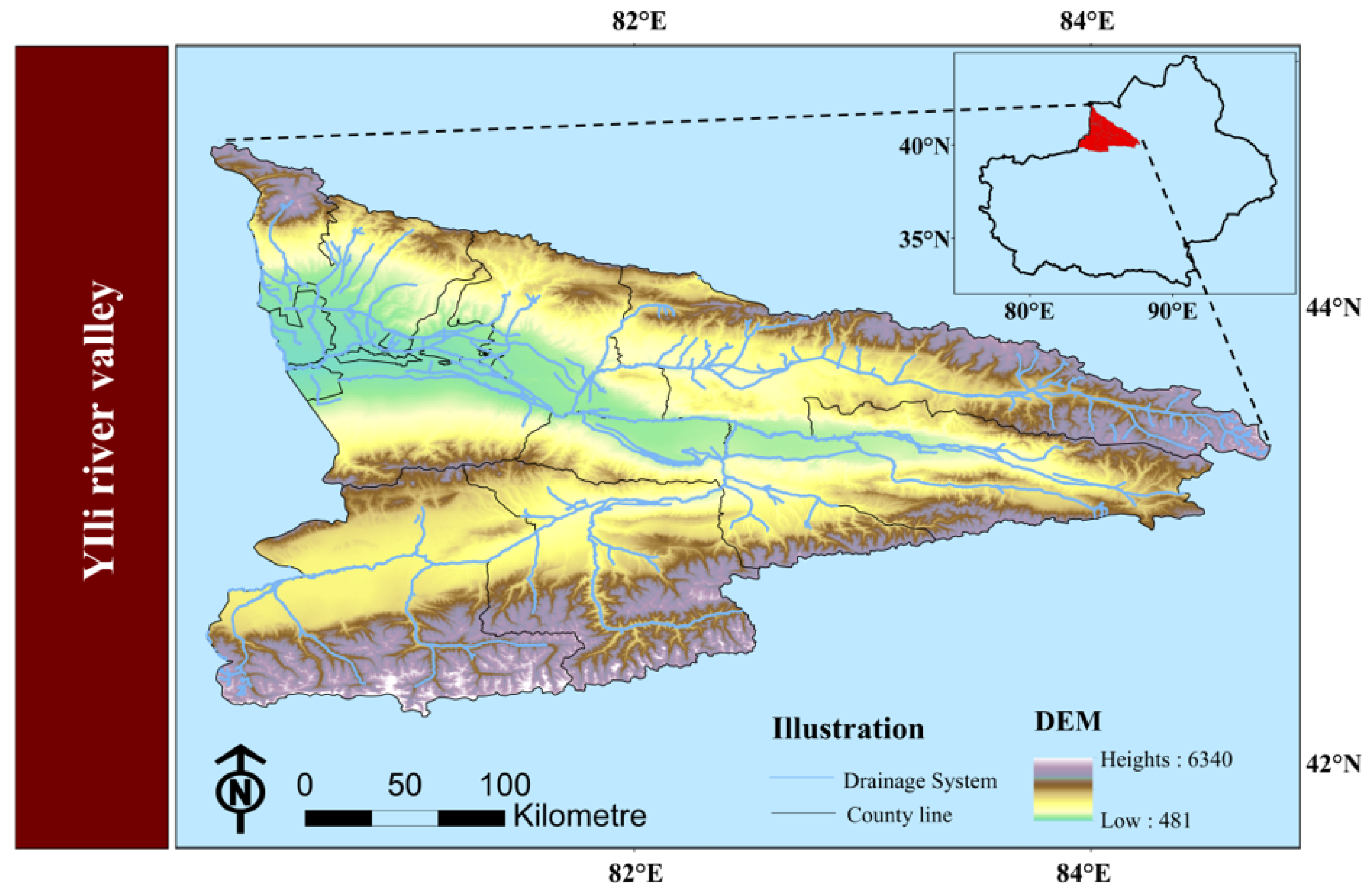
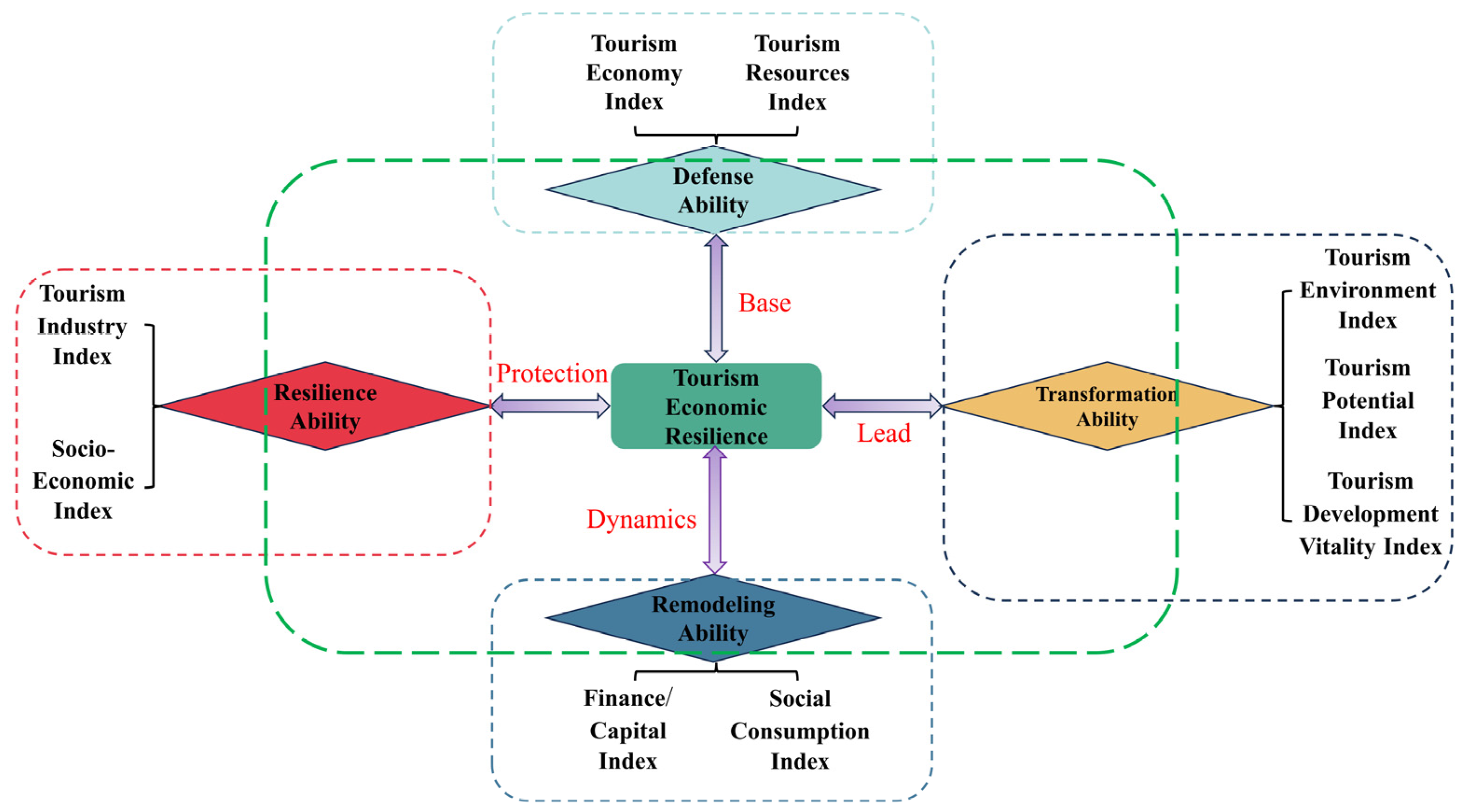
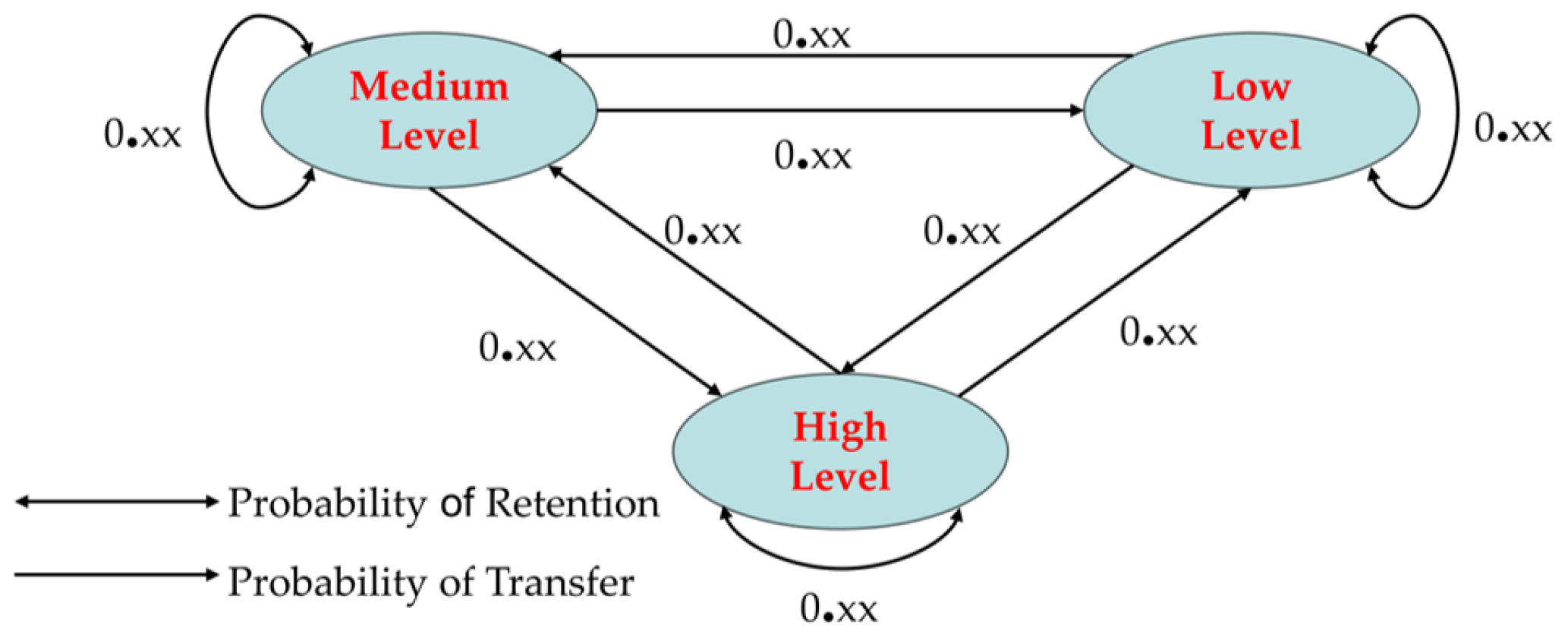
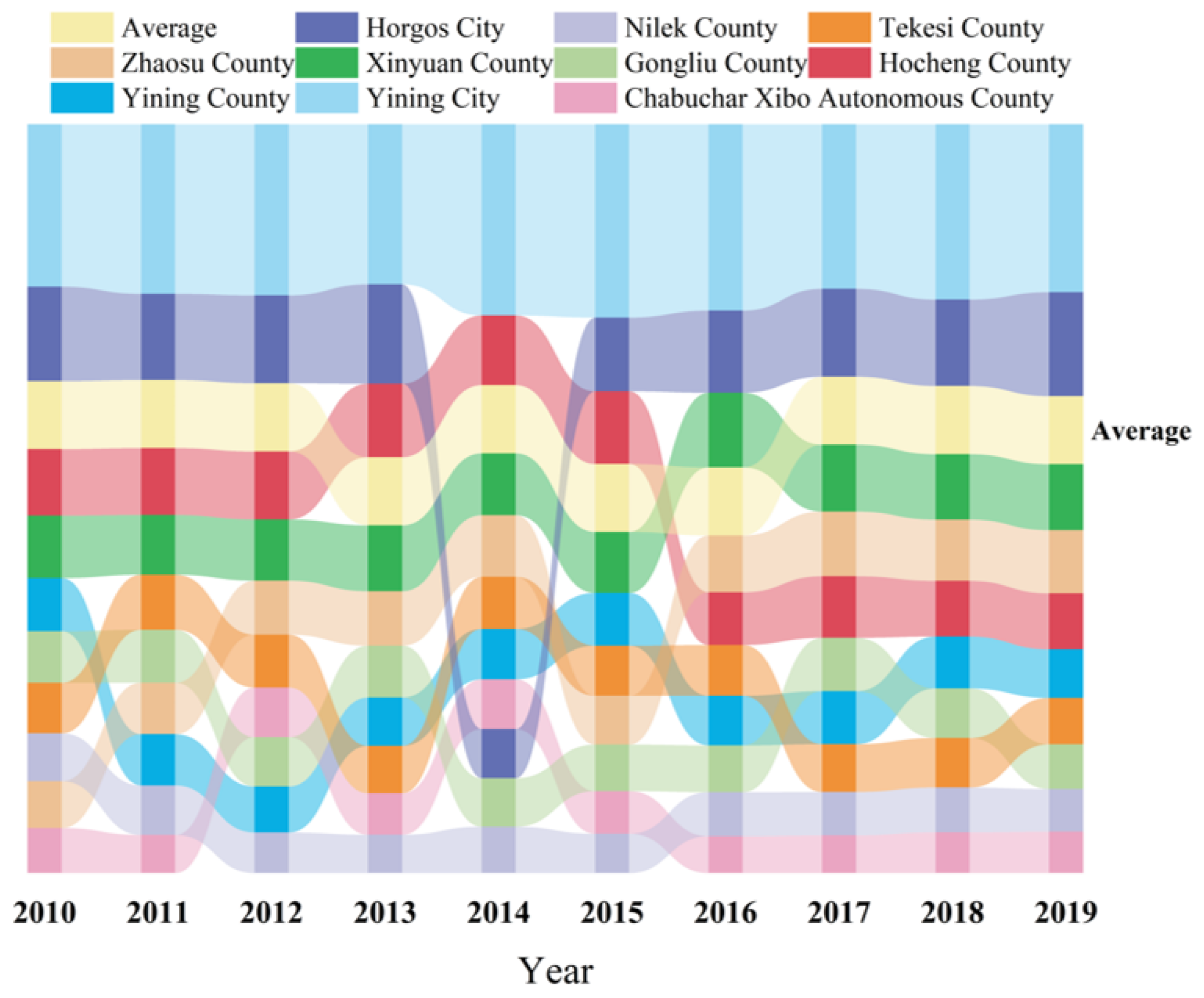

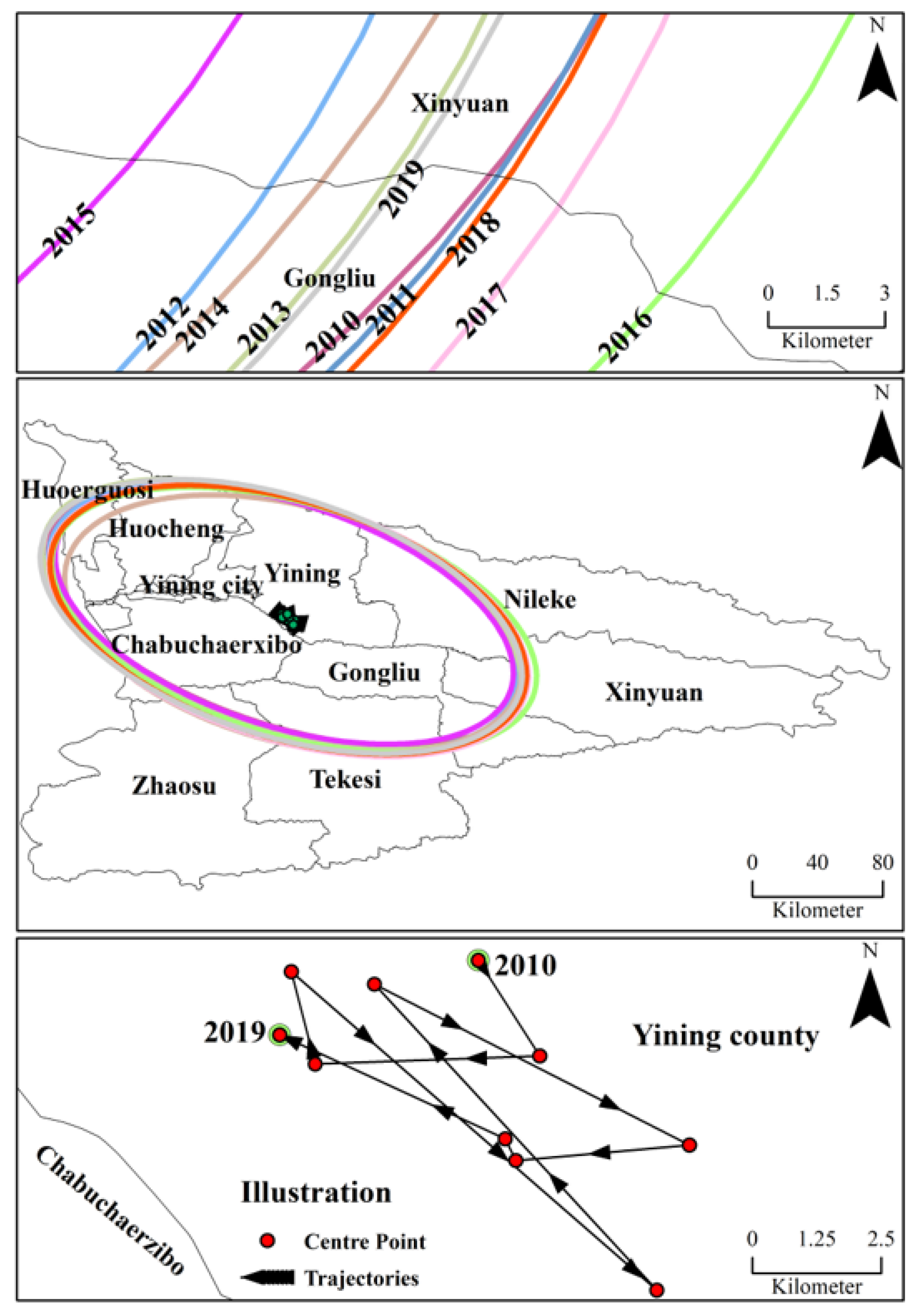
| Primary Indicators | Secondary Indicators | Tertiary Indicators | Unit | Weights |
|---|---|---|---|---|
| Defense Ability | Tourism Economy Index | Tourism Reception | ten thousand people | 0.048669 |
| Gross Tourism Income | 10 K CNY | 0.057321 | ||
| GDP per capita | yuan | 0.04359 | ||
| Tourism Resources Index | Number of A-grade scenic spots | pcs | 0.031395 | |
| Recovery Ability | Tourism Industry Index | Number of travel agencies | pcs | 0.112212 |
| Number of rooms in star-rated hotels | pcs | 0.072538 | ||
| Socio-Economic Index | Night Lights | / | 0.119606 | |
| Value Added of Tertiary Industry | billion | 0.07995 | ||
| Resident Population | ten thousand people | 0.022688 | ||
| Remodeling Ability | Finance/Capital Index | Investment in Social Fixed Assets | 10 K CNY | 0.042493 |
| General Public Budget Expenditure | 10 K CNY | 0.026415 | ||
| Social Consumption Index | Tertiary Industry Output Value as % of GDP | % | 0.03114 | |
| Total Retail Sales of Consumer Goods | 10 K CNY | 0.057466 | ||
| Transformation Ability | Tourism Environment Index | NDVI | % | 0.017156 |
| Waste Gas Emission | Million Nm3 | 0.009544 | ||
| Wastewater Emission | ten thousand t | 0.012967 | ||
| Comprehensive utilization rate of solid waste | % | 0.015342 | ||
| Tourism Potential Index | Number of students in secondary schools | people | 0.027383 | |
| Number of employees in the tertiary industry | ten thousand people | 0.050973 | ||
| Advanced industrial structure | % | 0.03508 | ||
| Urbanization rate | % | 0.020962 | ||
| Tourism Development Vitality Index | Ratio of tourists to permanent residents | % | 0.06511 |
| t/t + 1 | Low Level | Lower Level | Medium Level | Higher Level | High Level | n |
|---|---|---|---|---|---|---|
| Low level | 0.834184 *** | 0.159439 ** | 0.003827 ** | 0.002551 ** | 0 *** | 784 |
| Lower level | 0.01455 ** | 0.792328 *** | 0.189153 ** | 0.003968 ** | 0 *** | 756 |
| Medium level | 0 *** | 0.016173 *** | 0.809973 *** | 0.173854 *** | 0 *** | 742 |
| Higher level | 0.001403 ** | 0.001403 ** | 0.019635 *** | 0.887798 ** | 0.089762 ** | 713 |
| High level | 0 *** | 0 *** | 0 *** | 0.008451 ** | 0.991549 ** | 710 |
| Type of Field | t/t + 1 | Low Level | Lower Level | Medium Level | Higher Level | High Level | n |
|---|---|---|---|---|---|---|---|
| Low level | 1 | 0 | 0 | 0 | 0 | 0 | 0 |
| 2 | 0 | 0 | 0 | 0 | 0 | 0 | |
| 3 | 0 *** | 0 * | 0.571429 *** | 0.428571 ** | 0 *** | 28 | |
| 4 | 0 ** | 0 *** | 0.009901 ** | 0.80198 *** | 0.188119 * | 101 | |
| 5 | 0 * | 0 * | 0 ** | 0.009501 ** | 0.990499 *** | 421 | |
| Lower level | 1 | 0.837209 ** | 0.139535 *** | 0 *** | 0.023256 ** | 0 *** | 43 |
| 2 | 0 ** | 0.842105 *** | 0.157895 ** | 0 *** | 0 *** | 38 | |
| 3 | 0 *** | 0 *** | 0.9 ** | 0.1 *** | 0 ** | 10 | |
| 4 | 0 | 0 | 0 | 0 | 0 | 0 | |
| 5 | 0 | 0 | 0 | 0 | 0 | 0 | |
| Medium level | 1 | 0.917404 *** | 0.079646 *** | 0.00295 * | 0 *** | 0 * | 339 |
| 2 | 0.021505 ** | 0.892473 *** | 0.086022 ** | 0 *** | 0 ** | 93 | |
| 3 | 0 *** | 0.1 ** | 0.9 *** | 0 *** | 0 *** | 10 | |
| 4 | 0 | 0 | 0 | 0 | 0 | 0 | |
| 5 | 0 | 0 | 0 | 0 | 0 | 0 | |
| Higher level | 1 | 0 | 0 | 0 | 0 | 0 | 0 |
| 2 | 0 | 0 | 0 | 0 | 0 | 0 | |
| 3 | 0 | 0 | 0 | 0 | 0 | 0 | |
| 4 | 0 ** | 0 *** | 0 * | 0.75 ** | 0.25 *** | 24 | |
| 5 | 0 ** | 0 * | 0 *** | 0 ** | 1 *** | 102 | |
| High level | 1 | 0.763682 * | 0.228856 ** | 0.004975 *** | 0.002488 * | 0 *** | 402 |
| 2 | 0.0144 * | 0.7744 * | 0.2064 ** | 0.0048 ** | 0 ** | 625 | |
| 3 | 0 ** | 0.015942 *** | 0.817391 * | 0.166667 ** | 0 *** | 690 | |
| 4 | 0.001727 ** | 0.001727 *** | 0.022453 *** | 0.908463 *** | 0.06563 ** | 579 | |
| 5 | 0 ** | 0 * | 0 *** | 0.010695 ** | 0.989305 *** | 187 |
| Impact Factors | Representative Indicators | Properties |
|---|---|---|
| Defense Ability | Tourism reception (X1) | Forward |
| Gross tourism income (X2) | Forward | |
| Resilience Ability | Number of travel agencies (X3) | Forward |
| Night lights (X4) | Forward | |
| Remodeling Ability | Investment in social fixed assets (X5) | Forward |
| Total retail sales of consumer goods (X6) | Forward | |
| Transformation Ability | Number of employees in the tertiary industry (X7) | Forward |
| Ratio of tourists to permanent residents (X8) | Forward |
| Implicit Variable | X1 | X2 | X3 | X4 | X5 | X6 | X7 | X8 |
|---|---|---|---|---|---|---|---|---|
| r | 0.9029 | 0.8604 | 0.7716 | 0.8189 | 0.8880 | 0.8563 | 0.9111 | 0.8146 |
| p | 0.0000 | 0.0000 | 0.0000 | 0.0000 | 0.0000 | 0.0000 | 0.0000 | 0.0000 |
Disclaimer/Publisher’s Note: The statements, opinions and data contained in all publications are solely those of the individual author(s) and contributor(s) and not of MDPI and/or the editor(s). MDPI and/or the editor(s) disclaim responsibility for any injury to people or property resulting from any ideas, methods, instructions or products referred to in the content. |
© 2024 by the authors. Licensee MDPI, Basel, Switzerland. This article is an open access article distributed under the terms and conditions of the Creative Commons Attribution (CC BY) license (https://creativecommons.org/licenses/by/4.0/).
Share and Cite
Zhao, P.; Sun, H.; Zhao, X.; Song, C.; Xu, X. Spatio-Temporal Evolution and Driving Factors of Tourism Economic Resilience in the Yili River Valley. Sustainability 2024, 16, 5141. https://doi.org/10.3390/su16125141
Zhao P, Sun H, Zhao X, Song C, Xu X. Spatio-Temporal Evolution and Driving Factors of Tourism Economic Resilience in the Yili River Valley. Sustainability. 2024; 16(12):5141. https://doi.org/10.3390/su16125141
Chicago/Turabian StyleZhao, Pengkai, Haojie Sun, Xinyu Zhao, Changying Song, and Xueting Xu. 2024. "Spatio-Temporal Evolution and Driving Factors of Tourism Economic Resilience in the Yili River Valley" Sustainability 16, no. 12: 5141. https://doi.org/10.3390/su16125141





